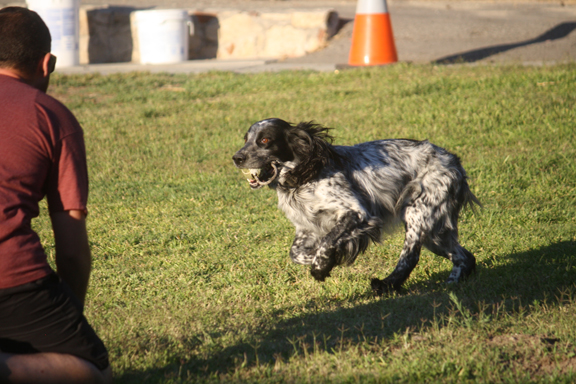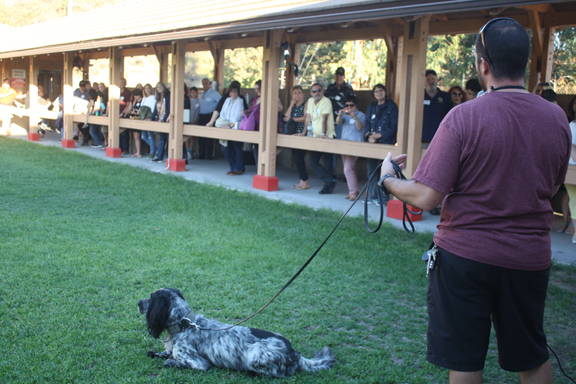
Petey with a toy as his handler Officer Alex Rolando watches.
By Mary O’KEEFE
On Saturday, the Glendale Police Dept. K9 Unit invited supporters to the first GPD K-9 Appreciation Dinner and Demo. The event was sponsored by the Glendale Police Foundation.
The guests arrived at the Glendale Sports Complex in the early evening on Saturday and were shuttled up to the Glendale firing range to spend the evening seeing exactly how their donations were spent.
“The purchase of the dogs and the training is really all funded by you,” said Chief Carl Povilaitis addressing the crowd.

It was in 2005 when then-Chief Randy Adams presented the idea of a K9 Unit to the Glendale City Council. At the time he made a commitment that the program would be funded by the community, and it has been. Individuals and businesses have supported the K9 Unit not only by purchasing the dogs and paying for their ongoing training, but their donations have also purchased equipment and paid for veterinary services.
Sgt. Shawn Sholtis, the lead officer of the K9 Unit, wanted to thank those who have supported the Unit by inviting them to dinner and giving them a chance to meet the K9s and the officers who are their handlers.
Povilaitis shared an example of one of the cases the K9 Unit was on.
“It was a foot pursuit. We weren’t able to locate [the suspect] but the dogs did. [The suspect] was under his house but he was bound and determine not to come out,” he said.
The GPD policy is to not allow the dogs to go under a house to get a suspect. In this case, police had to use tear gas to get the suspect to eventually come out from under the house.
Povilaitis said the use of the K9 Unit keeps officers and the public safer.
“This is the first opportunity we have had to simply say ‘thank you.’ This is not a fundraiser; we just want to thank you,” he said. “We could not do it without you.”
Then it was time for the dogs to shine. Petey, an English Springer Spaniel, was up first. He works with the Narcotics Unit.
“Petey only finds drugs,” said his handler.
As part of a demonstration, officers hid some narcotics under a cone in the demonstration yard. The handler told the audience where the drugs were hidden, a practice he normally doesn’t do during a demonstration.
“But I want you to see the change in [Petey’s] behavior,” he said.
Petey ran around the yard, sniffing while seemingly having fun, but then his demeanor changed as he focused in on the drugs. He went directly to the cone.
In another demonstration, Eddie and his handler Officer Matt Wilson showed how the dogs locate suspects.
Eddie was new to the Unit; he replaced Duke who had retired.
“Duke came down with a medical problem,” Wilson said. “He had spine surgery.”
After surgery, it was determined Duke could not go back to work, so now he is living a good life with Wilson.
“He is getting fat and loving life as a house dog,” he said.
Eddie is 3 years old and is “extremely social.” Wilson explained how the dogs are trained and the importance of getting and keeping the dog’s attention. At present, Eddie is certified for patrol, meaning he finds the “bad guys,” but he will soon be able to work with narcotics.
“I have been working with the [K9] Unit for a few years now and I am constantly amazed at how useful they are in the job we do,” said Sholtis.
Wilson and Officer Eric Meyer, with his K9 Jeff, shared how their dogs work in different scenarios including finding suspects. There was a demonstration of how K9s can be used when suspects hide inside cars. A man in a protective bite suit sat in a vehicle. The happy dog suddenly became serious, focused and ran directly to the suspect in the car and grabbed his arm.
Training is paramount to everything the dogs do. It is important for the dogs and the officer handlers to work together.
“Obedience is [the] center in everything we do. All our sessions begin with obedience to make certain the dog is listening,” Sholtis said.
Training begins with dogs on the leash, then off leash. They listen closely to every command the officers give. When they work together, the handlers always keep the dogs in sight when they are on a search.
Sholtis gave an example of what officers do when they enter an apartment complex. The K9s may go in front of the officers but are always in the officer’s sight.
“We keep them in eyesight to see any change in the behavior,” he explained.
At the end of the night, those who donated to the program were pleased to see how their funds were used and were duly impressed by the K9 Unit.
Donations to the GPD K9 Unit are welcomed and appreciated. Anyone who would like to donate can do so by visiting gpf.org, emailing info@gpf.org or calling (818) 279-1672.
